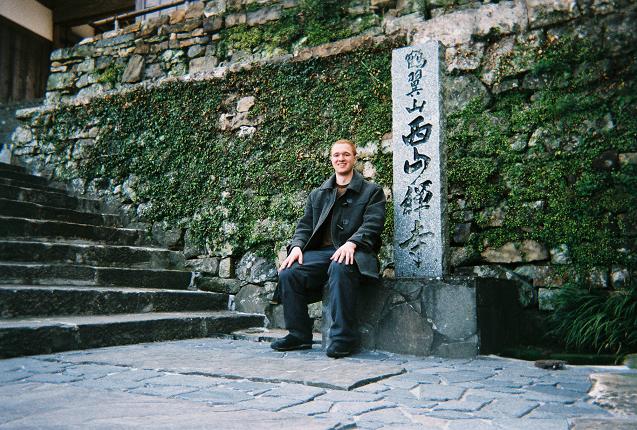
Me at Seizanji (Taken by Hwang Jong-in) | A Summary of My Trip to Tsushima with an Emphasis on Korea-Japan InterchangeBy Charles WetzelNote: Professor Bryson Clevenger at Northern Virginia Community College has put his stamp of approval on this photo essay with a score of 95%! Please note that historically-oriented paragraphs are bolded so Professor Clevenger can find them more easily. The non-bolded portions generally discuss modern Tsushima. Admittedly, until a few hours before taking a ferry to Japan, I had no idea even which Japanese island I was going to travel to. The purpose for my trip to Japan was twofold: I needed to leave Korea and go to another country to reset the 90-day time frame on my 90-day multiple-entry C-3 visa (for South Korea), and I wanted to report on an Asian country for my HIS 253 class (History of Asian Civilizations I) that ISN'T Korea. Sure, Korea is representative of East Asia, but this term, I've done nothing but talk about Korea-this and Korea-that. I figured it was time to report on another country. I needed to broaden my perspective. So on Saturday, March 22, 2008, I strolled into the Busan Ferry Terminal and asked something like "which is the cheapest ferry ticket to Japan?" The woman behind the counter replied that the cheapest round-trip ticket, at a mere $103.58 round trip, was a ticket that went from Busan to Izuhara (on Tsushima Island, known in Korean as Daemado) and then from Hitakatsu (also on Tsushima Island) back to Busan. So I took this incredibly cheap ticket, and set out on my lowest-budget-ever trip to Japan (excluding connections through Tokyo Narita Airport). I had been eagerly anticipating this trip, and was very excited that I would soon get to return to Japan. Last year, for another visa run, I had gone to Fukuoka, and had been impressed with what I had seen: the cleanliness, the palm trees, and of course, the gigantic Yodobashi Camera store that sold a lot more than just cameras. After waiting a little while, I got onto the ferry, a vessel with two hulls, two levels jam-packed with seats, and a screen up front that was playing SBS (Seoul Broadcasting System). I was exhilarated to be on my way to Japan again. |
I dozed off on the ferry quite a bit due to having slept on the floor of a jjimjilbang (bath house) the night before, but still managed to take in a few details. First of all, the South Koreans, never hesitating to point out ways they've been wronged by Japan, had attached pieces of cloth to the back of every seat on the Korea-Japan ferry proclaiming that Dokdo (Takeshima, a disputed territory between Japan and Korea) is KOREAN LAND. While it is not uncommon to see this slogan everywhere in South Korea, I found it interesting that they slap it onto the seat backs of every seat on an international ferry between Korea and Japan!
Soon, we arrived in Japan and went through the regular procedures: customs, being fingerprinted (a recent thing), etc. I finally got out of the building, and before I knew it, this guy came up to me and started speaking Japanese. I asked if he spoke Korean (a reasonable question considering that Tsushima Island is a major tourist destination for South Koreans). I speak good Korean, but haven't formally studied Japanese. Well, I was in luck. This guy IS Korean. Not only is he Korean, but he speaks fluent Japanese and is a TOUR GUIDE on Tsushima, and wanted to give me a free tour of the island! While I had wanted to tour Tsushima on my own, I realized that a free tour guide might come in handy, in light of the fact that I needed to see a lot of Tsushima's important sights within less than 24 hours before the return ferry departed.
Day 1: Izuhara
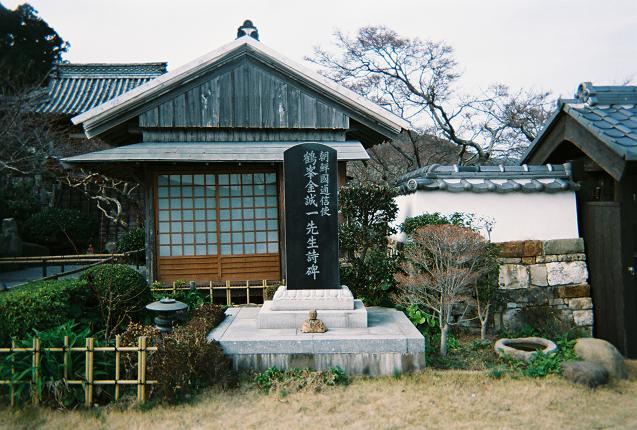
Kim Sung-il's Monument, Taken with the Permission of the Monk Inside | Jong-in informed me that Kaneda Castle, a place I had been wanting to visit, was too high in the mountains to reach in a timely manner if I walked, and if I took a taxi, it would come out to roughly $30 (because taxis in Japan are expensive). Unacceptable. So I asked him for other suggestions. His first suggestion was called Seizanji. Seizanji is a temple in Izuhara. It is currently a youth hostel, which may seem strange until one considers that it's been a place of lodging for travelers for literally hundreds of years. Seizanji was used for lodging by the Ilbon Tongshinsa ("Communications Men to Japan"). Starting around 1607, according to Jong-in, four or five Koreans at a time would enter Tsushima (presumably through Izuhara Harbor, which is walking distance from Seizanji) and stay at Seizanji, exchanging letters and so forth between the king of Joseon and the Shogun (Janggun in Korean). One famous Ilbon Tongshinsa, known as Kim Sung-il, has a biseok (monument) at Seizanji, pictured to the left. He was so famous, he received a nickname, Hakbong (nicknames tended to be given to only the more famous Ilbon Tongshinsa, apparently). |
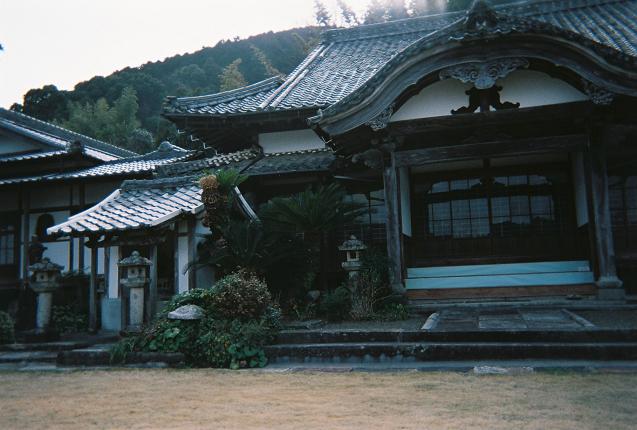
Another View of Seizanji Temple/Youth Hostel, Taken with the Permission of the Monk Inside
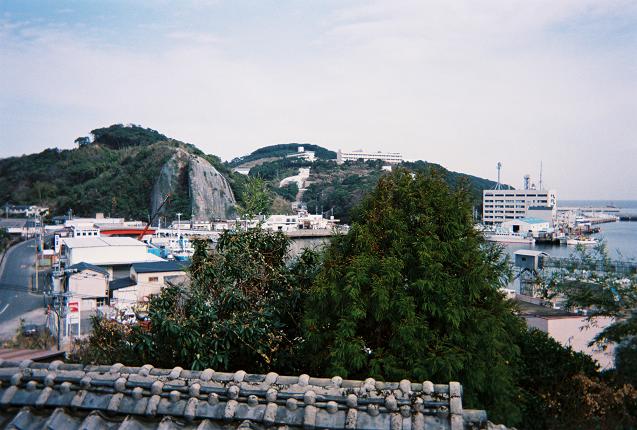
This is Izuhara Harbor. It has been a culturally significant harbor for interchange between Korea and Japan due to its close proximity to what is now Busan (taken from a high road somewhere between Seizanji and Shuzenji).
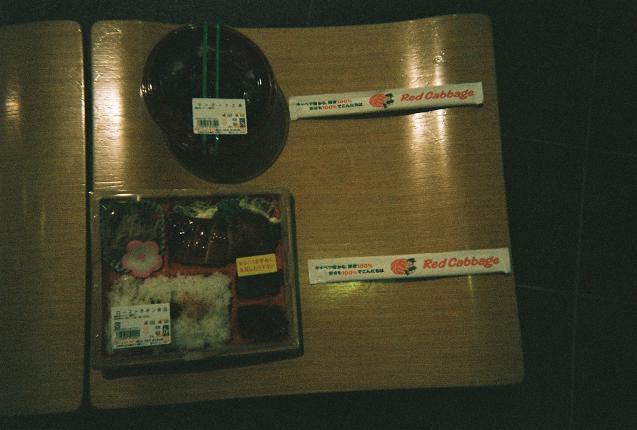
Japanese Lunch Boxes from the Local Red Cabbage Supermarket, Relatively Cheap
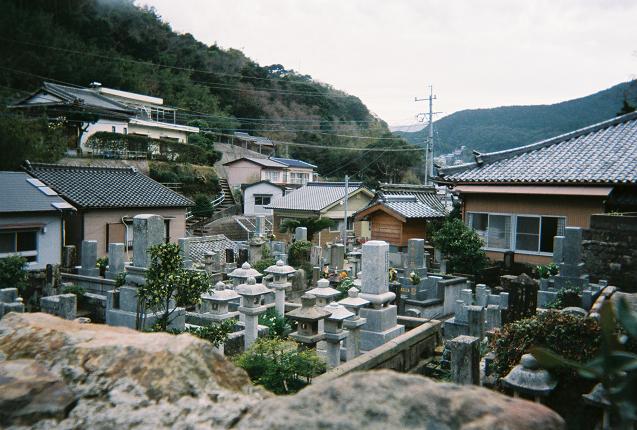
View of Shuzenji | Hwang Jong-in brought me to Shuzenji, an important site where a well-known Ilbon Tongshinsa was buried. Unlike in Korea until relatively recently, Japan practices cremation (known in Korean as "hwajang"). This is basically a graveyard for hwajang yumul ("cremated remains"). In fact, several of the stone slabs were written in both Japanese and Korean in the honyong form (mixed hangeul alphabet and hanja [Chinese characters]). |
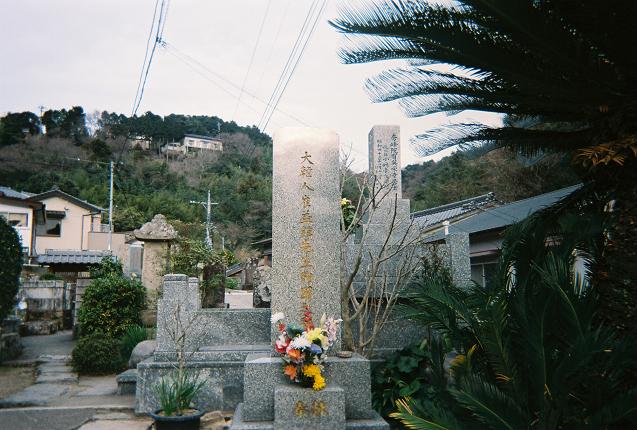
The Biseok (Monument) of an Important Tongshinsa
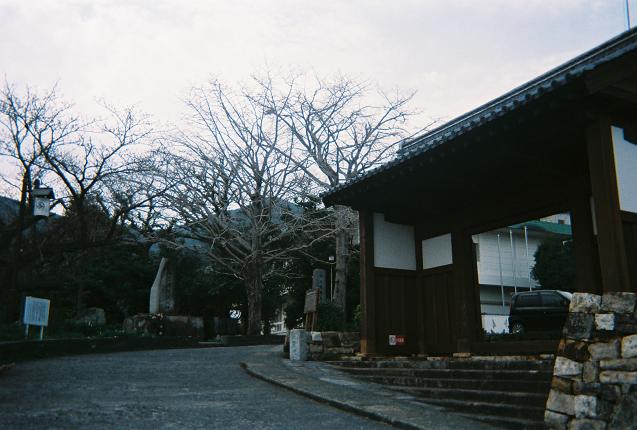
Goryeomun (Literally "Korea Gate") | Goryeomun, a distinctly Korean-style gate, was constructed near Kaneishi-jo ("jo" means "castle" in Japanese) to signify friendship between Korea and Japan. It is in Izuhara, and is still a popular tourist destination for Koreans. |
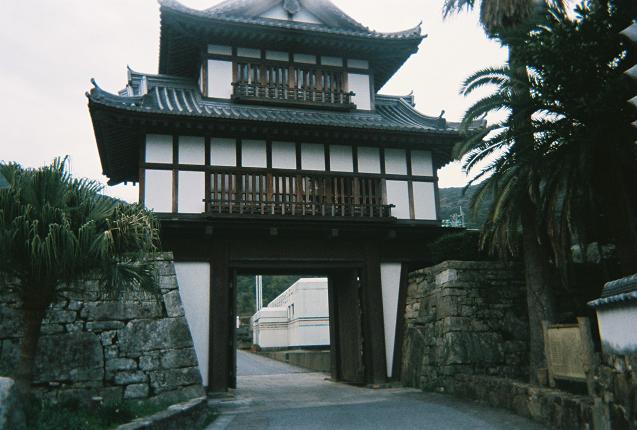
Kaneishi-jo's Reconstructed Gate | To the left, you can see Kaneishi-jo's main gate, located very close to Goryeomun. It was not clear from the sign at Kaneishi-jo's gate when Kaneishi-jo was built, but it did state that the castle was destroyed during internal fighting in 1528. It was rebuilt several times throughout Japanese history (including a major overhaul in 1669 when Yoshizane added turrets, etc). It did not have a donjon, but was apparently a formidable castle nonetheless! It was last rebuilt in 1990, though unfortunately most of what used to be the interior of the castle has been used for other purposes (like a run-down swimming pool, as you will see in the next picture). It has been known as "Fujo" ("Tsushima Lord's Castle"). |
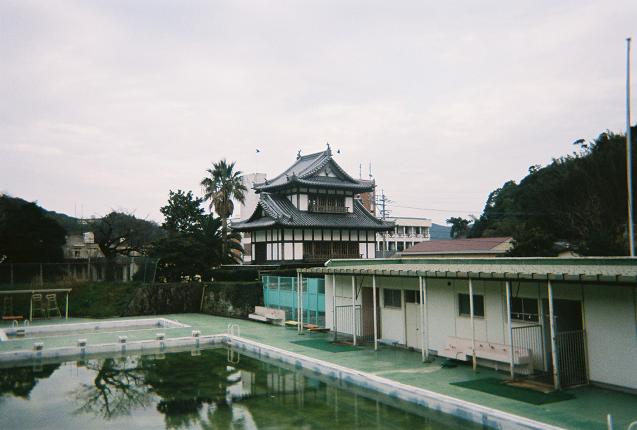
Kaneishi-jo's main gate may have been rebuilt, but most of the rest of the land the castle once stood on is now used for much more mundane things!
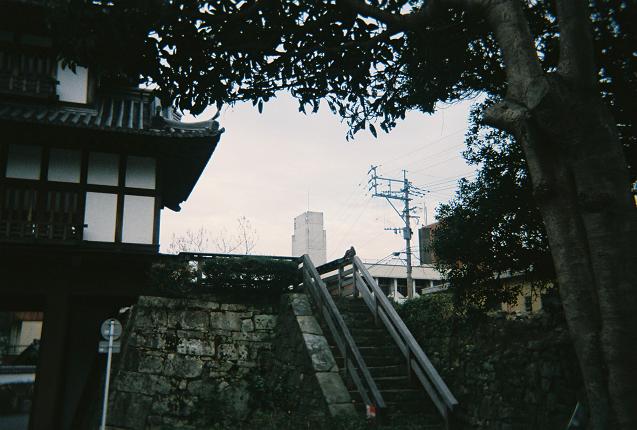
Exotic Bird Sitting on the Stairs of Kaneishi-jo's Main Gate, Barely Visible
Inside the grounds of the former Kaneishi-jo, there is a biseok (monument) to Deokhye, an important Korean woman who visited Tsushima long, long ago. She later went on to have a daughter by the king, though her daughter was not a gongju (princess), but rather an ongju (a term referring to children born of one of the king's second, third, etc. wives). She apparently had a mental illness later in her life. However, this doesn't stop Korean tourists from piling lots of Korean won coins on her monument.
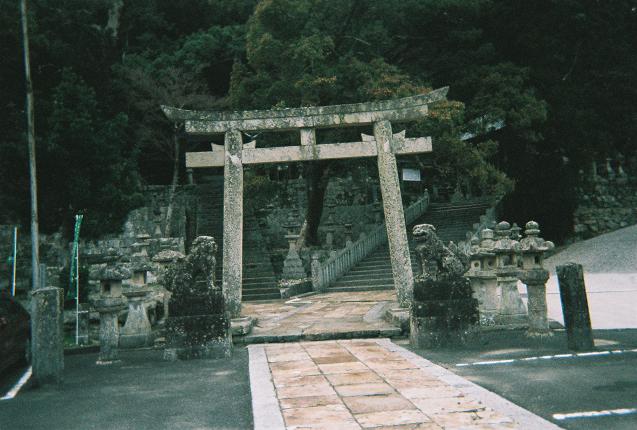
Torii for a Site with Multiple Jinja | After touring Kaneishi-jo, Hwang Jong-in guided me to a site with several jinja (known in Korean as "shinsa"). Jinja are the places that kami (Shinto spirits) are supposed to reside. Note in the picture to the left the Korean lions. This is, however, really the only Korean influence on this site. When entering a jinja there is a ritual that one is supposed to perform. It involves bowing twice, clapping twice, and then bowing again, all in the direction of the jinja. |
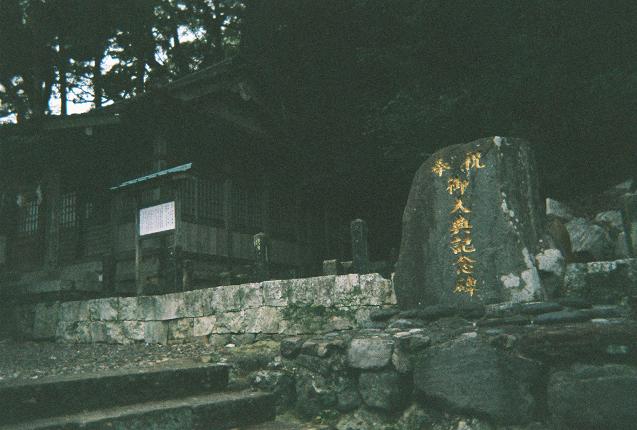
Relatively Unimportant Building, According to Jong-in, but Visually Impressive
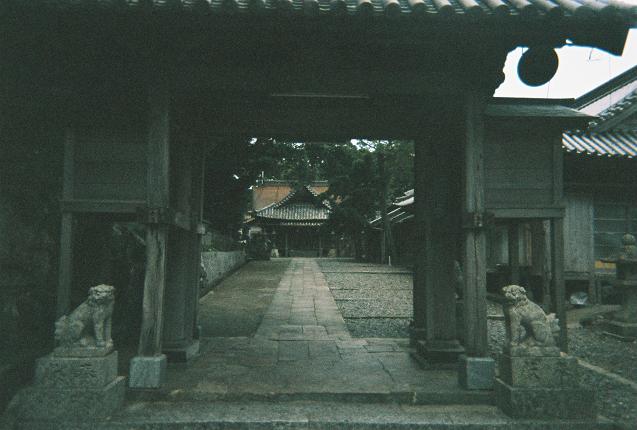
This is an especially important jinja -- so much so, that rather than bowing twice, clapping twice, and bowing again, you are supposed to clap FOUR TIMES.
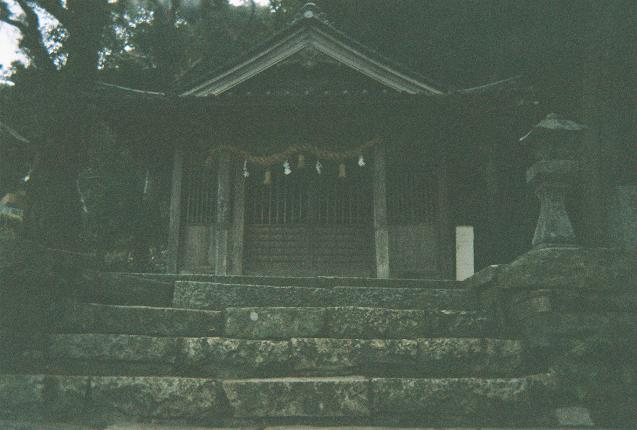
Another Important Building High Up at the Multi-Jinja Site
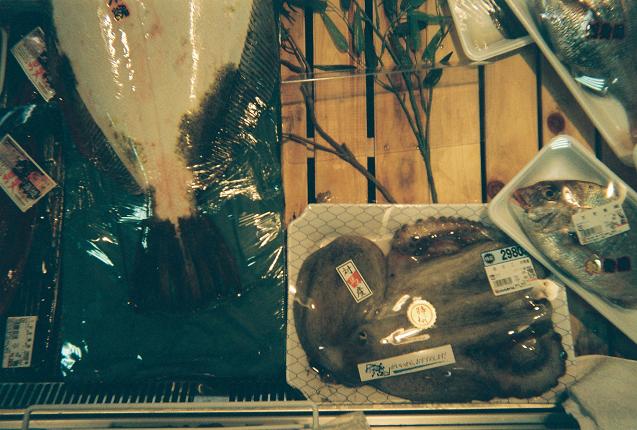
Japan's proximity to the ocean means there is a lot of seafood in Japan's diet -- duh.
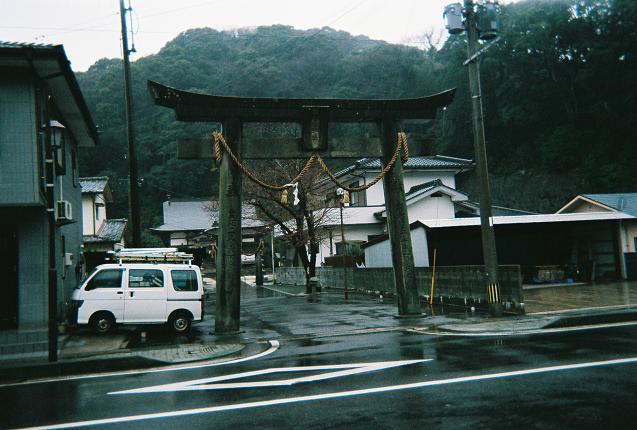
Random Torii in Izuhara
Having completed our sightseeing for the day, Jong-in found us a very cheap place to sleep, which was only 3,000 yen per room (by today's exchange rate, that's $30.14). It is known as a minshuku in Japanese, or minsuk in Korean. Interestingly enough, the building doubles as a hasuk/geshuku (boarding house for students). For 7,500 yen a month ($753.53), you get a room and two meals a day. Anyways, it was very clean, had authentic tatami mats, etc.
Jong-in and I had some cans of cheap Japanese malt liquor and Jong-in showed me the proper way to eat natto (fermented soybeans available from the local supermarket for 102.90 yen [$1.03] for three packs). You are supposed to grab the plastic in the center with your thumb and forefinger and twist. That minimizes the amount of wasted beans that stick to the plastic. In case you were wondering.
Day 2: Hitakatsu
In the morning, I got on a bus to Hitakatsu. It was an incredibly long ride for such a tiny island (with only 40,000 people). It took well over two hours, and cost 1,000 yen ($10.05), though had I been Japanese, it would have cost three times that much. It's a special foreigner discount. Yippee!I soon arrived in Hitakatsu. It was raining quite heavily. I was wet. Darn it.
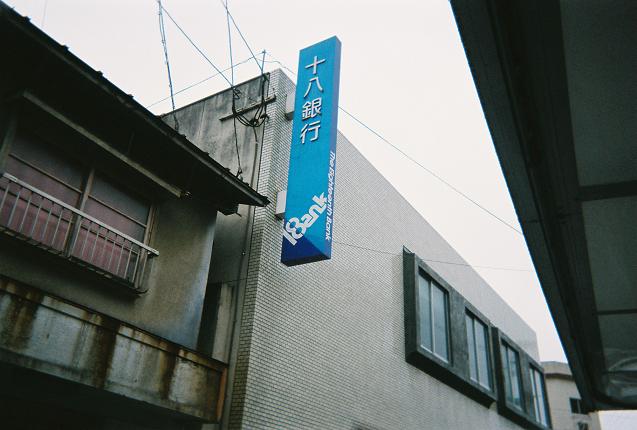
You may wonder why I took this picture -- ask a Korean (one who can read some Chinese characters), and maybe you'll get a laugh out of it, too.
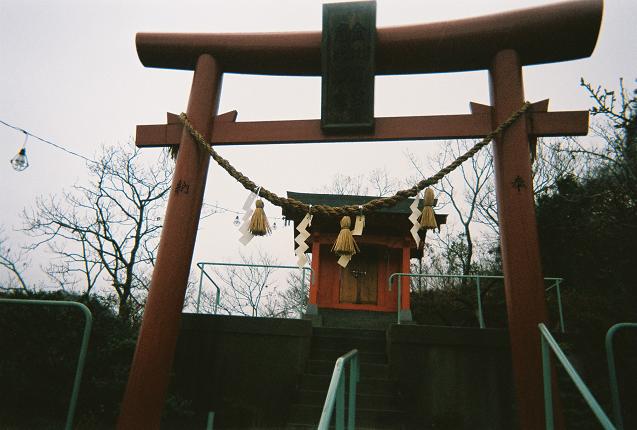 | Near Hitakatsu Harbor, there is a hiking trail in the mountains that is exactly 1 kilometer long. To the left is a torii marking the beginning of the mountain trail. Along the trail there are memorials and images of Buddha. Please note that in Japan, stone Buddhas frequently have little Buddha clothes hanging from them. This is rare in Korea. |
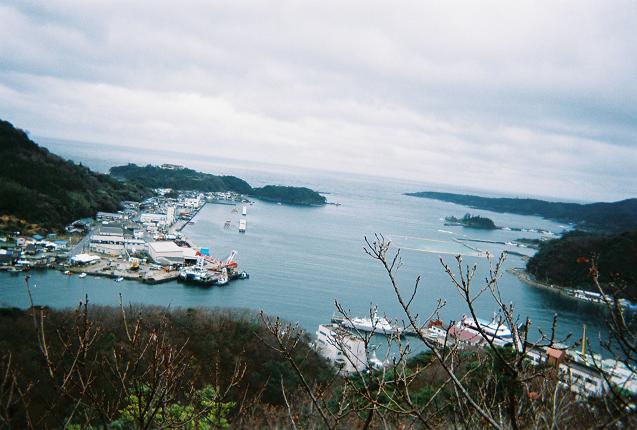
This is a view of Hitakatsu Harbor, a historically important harbor located over two hours away by bus from Izuhara, taken in the most tree-free region of the mountains I could find.
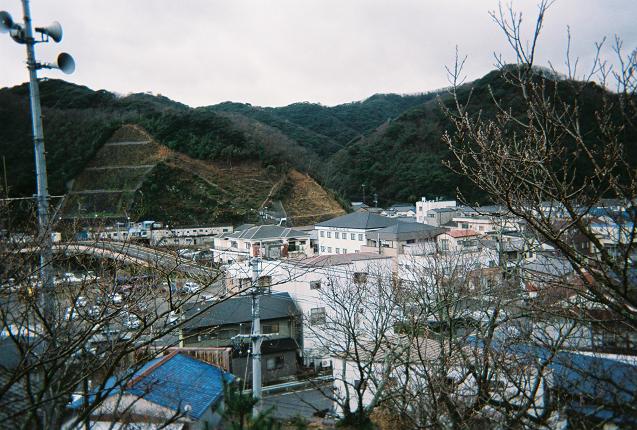
Hitakatsu from the Other Side of the Mountain | You walk a kilometer through the mountains of Hitakatsu, and you are rewarded with a picnic table! There appears to be nothing to see here. So I made the most of it, stood on top of the picnic table, and got this view of Hitakatsu from the other side of the mountain. |
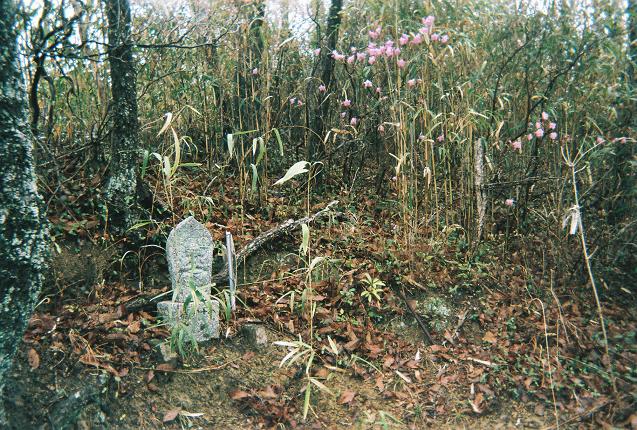
Lots of Buddha statues adorn the mountain trail in Hitakatsu, like this one, the picture of which I took when retracing my steps back to the entrance of the trail.
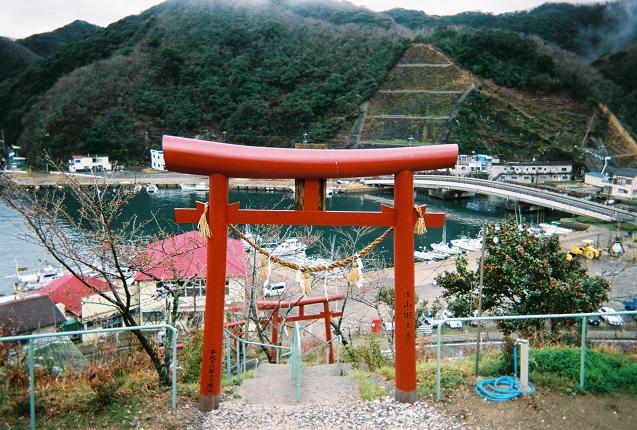
Hitakatsu Harbor and a Torii
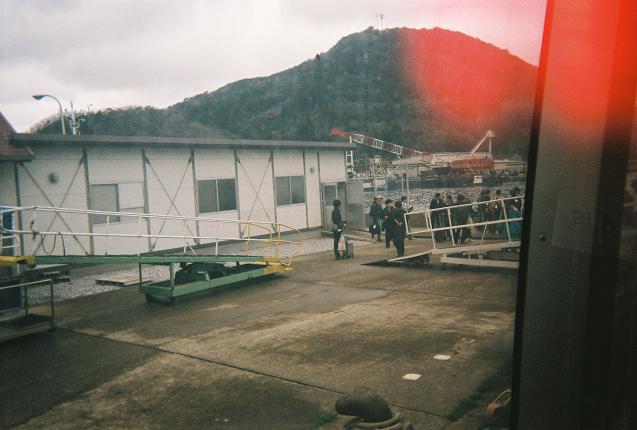
View from the Sea Flower (Ferry), Just Before Departing Japanese Waters for Busan Harbor

























